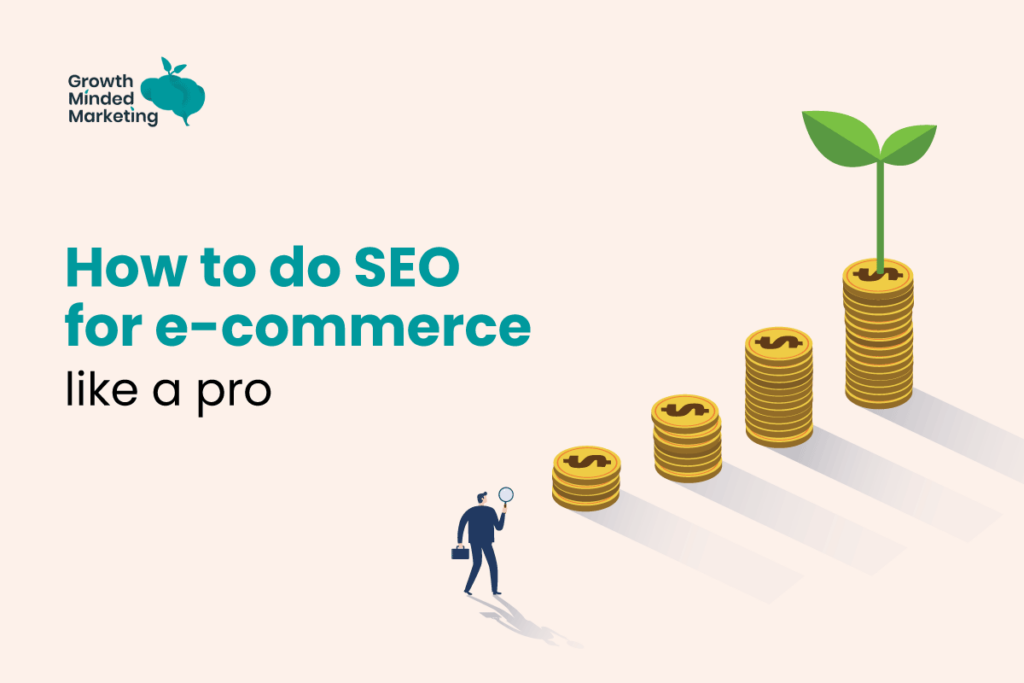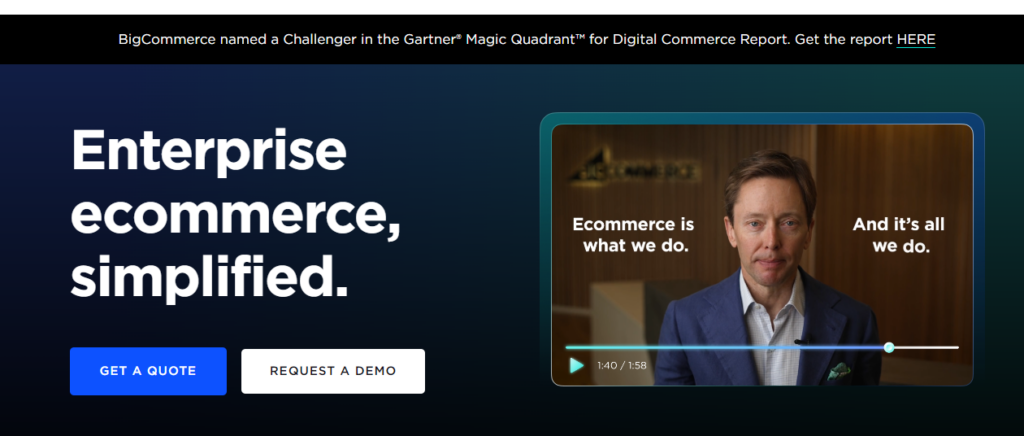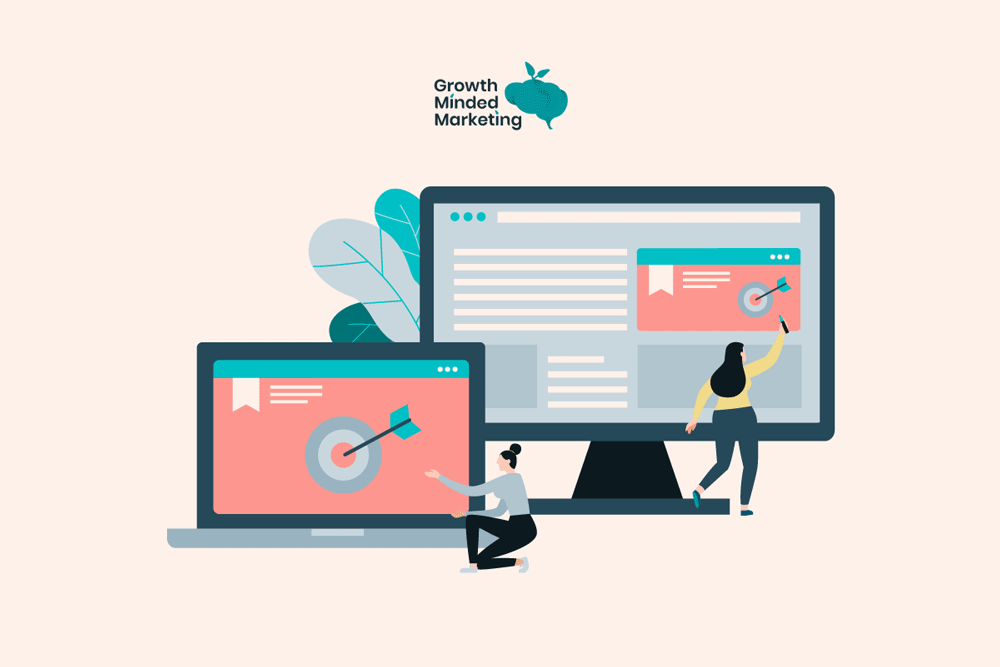E-commerce is growing rapidly across the globe. More than 2.64 billion people globally purchased a product or service online in 2023. Global e-commerce sales are expected to cross $8.1 trillion by 2026.
It is a huge market – with a lot of competition.
Just having an e-commerce store isn’t enough. You have to have a solid online marketing strategy with well-defined marketing channels and touchpoints to connect and interact with your target audience.
Search engines are an essential touchpoint that the majority of people will use to find what they are looking for on their purchasing journey.
And this makes search engine optimisation essential for e-commerce businesses.
Table of Contents
ToggleWhy is E-commerce SEO Important?
Optimising your ecommerce store is an obvious way to improve rankings and drive more organic traffic to your store. Research shows that more than 33% of traffic to e-commerce sites is attributed to search engines.
You have to be where your customers are and since search engines are the first place people look for when they need something, SEO becomes a must-have for e-commerce sites.
The real fun begins when you understand the importance of organic traffic for your online store. Here are a few statistics that show the significance of organic traffic:
- Ecommerce SEO has a whopping ROI of 1,600% compared to paid traffic making organic traffic more profitable
- Organic traffic is cost-effective and much cheaper than paid traffic in the long term
- Low cost leads to lower customer acquisition cost, high customer lifetime value, and high ROI
- Organic traffic is sustainable and evergreen. The content you have published today should keep driving traffic for years to come
- SEO improves your store’s credibility, authority, and trustworthiness as nearly 68% of online interactions start with a search engine and this leaves a great impression on people who search for your brand or products
- Content marketing and distribution help you reach your target audience through different channels that you can’t explore without content and SEO.
Further Reading
How to do SEO for an E-commerce site?
Search engine optimisation for an e-commerce website requires a well-defined SEO strategy with a goals and plan of action.
Here are the best practices for ecommerce SEO:
1. Keyword research
Keywords are the backbone of e-commerce SEO. Finding and targeting the right keywords in SEO is essential for success. You have to go beyond keyword difficulty during the keyword research process.
There are a couple of key factors to consider when looking for keywords to target:
- Search intent
- Competition.
Understanding the purpose of the search query and a clear understanding of the intent is essential. Most e-commerce businesses target transactional and commercial keywords and don’t focus on informational and navigational keywords:
A common reason why most e-commerce businesses don’t target informational keywords is that they don’t have a blog and don’t actively publish new content (more on this in the section below).
Besides, Amazon is a goldmine for ecommerce. Even if you don’t plan to list your products on Amazon, you should use it for keyword research. Use a keyword research tool to find Amazon keywords or use Amazon’s autocomplete feature to find appropriate keywords.
It’ll give you a lot of untapped keywords that most of your competitors aren’t targeting.
Most of the time, looking at what keywords your competitors are targeting is a nice idea. Tools like SpyFu give you a holistic overview of what keywords they are targeting, what paid keywords they are bidding on (which means they are profitable), and lots of useful insights.
All of this can be done with a keyword tool like Ahrefs of Semrush. These paid tools will do the heavy lifting for you as they cover search intent, keyword difficulty, search volume, Amazon research, competition analysis, and pretty much everything you need to find the right keywords for your ecommerce SEO.
2. Optimise product pages
A keyword research tool can generate reports but can’t optimise your store. That’s something you have to do and how you use keywords for optimisation makes all the difference.
Product pages are where you have to use keywords strategically to outrank your competition in SERPs.
Your product page should have at least 9 must-have elements:
Here’s a breakdown of the elements on your product page that must be optimised for SEO:
- URL: The URL should have your primary keyword. Keep the URL short and descriptive
- Product title: Your primary keyword should be in the product title (H1) and it should be consistent with the URL and page title
- Subheadings: Adding relevant keywords in subheadings and short descriptions is a good idea as it helps search engines make more sense of the content on product pages
- Product images: Add alt text for all the product images. You don’t have to add keywords here. Adding relevant, descriptive text in alt tags is an essential part of SEO. Don’t ignore it. Don’t confuse having alt text with adding keywords in the alt text
- Product description: This is the crux of the product page. The description should be distributed into small chunks of text with proper subheadings, bullets, and lists where necessary. Add relevant keywords naturally in the description
- Canonical tags: Duplicate content hurts search engine rankings and it must be avoided. If you are using product variations, you must use canonical tags to avoid duplicate content
- Improve page load speed: Your product page should be optimised for speed. It needs to load quickly, preferably in less than a second. Compressing, lazy loading, and using WebP format for product images can significantly reduce load speed as product images take the most space on an e-commerce product page.
3. Optimise category pages
Your ecommerce store doesn’t just rank for its product pages, it ranks for category pages as well. Not optimising e-commerce category pages (and treating them like blog categories) is suicidal for e-commerce SEO.
Optimised category pages don’t just rank in SERPs and bring organic traffic, but they can be used to hook visitors and convert them into customers via exceptional UX. Here’s an example of an optimised ecommerce category page:
Each of your category pages should be based on a primary keyword (refer back to keyword research). This helps with keyword targeting and helps you organise products.
You need to add helpful content on category pages to make sure they rank in SERPs. Unique and helpful content for all category pages has two key SEO benefits for e-commerce:
- You can target relevant keywords and improve rankings. Search engines are more likely to rank a category page with content as opposed to a category page that only has product listings
- You can avoid duplicate content by creating unique content for category pages. Multiple category pages listing the same or similar products end up being duplicates and this has a negative impact on SEO.
Writing content is just the beginning, here are category page optimisation best practices you should follow for ecommerce SEO:
- Follow all the on-page SEO best practices when creating and optimising category pages
- Add heading tags with a proper title
- Add internal links to other categories, sub-categories, and product pages across all category pages.
- Check what your competitors are doing. It will give you a nice idea of what’s working for them for category pages (and how Google responds)
- Add breadcrumbs for better UX
- Don’t hesitate to merge categories when you have overlaps.
4. Invest in content
Having content on product and category pages isn’t always enough: sometimes having a blog is inevitable to achieve your SEO growth targets.
Why?
Because creating blog content helps drive organic traffic by targeting top-of-the-funnel keywords, creates an additional touchpoint, boosts your store’s credibility, and establishes authority.
Research shows that blogging increases ecommerce sales by 6% which doubles to 12% for businesses that blog regularly. Businesses that publish more than 16 blog posts per month receive 3.5x more traffic than businesses that publish 0-4 posts per month:
You shouldn’t ignore ecommerce blogging. It pays off big time.
If you don’t have a blog, create one. If you already have one, start publishing new content regularly.
You can check out this detailed guide on developing a successful SEO content strategy.
Here are some actionable tips and techniques to capitalise on SEO for e-commerce using a blog:
- Create an editorial calendar based on keyword research so you can create content for your audience that it actively searches
- Focus on informational, navigational, and commercial intent as these are hard to target with product and category pages
- Use buyer personas to create content for all stages of the funnel
- Build an email list using a lead magnet. This helps you build a community of engaged subscribers
- Expand your reach by syndicating and distributing content across platforms and sites. This helps you reach new audiences that can’t be reached otherwise.
5. Acquire backlinks
Whether it’s a killer blog, a clearance sale, or a newly launched product, you need to promote it to drive organic traffic. Search engines use a lot of factors to index and rank search results and backlinks are the most valuable ranking factors.
A study by Semrush confirmed that backlinks and the number of referring domains are among the top factors in reaching Google’s first page:
A study by Ahrefs showed similar results where new backlinks help maintain top rankings. A study of 11.8 million search results found a strong positive correlation between rankings and the number of unique backlinks.
So, acquiring backlinks from unique, relevant domains is an essential part of SEO for ecommerce. You need backlinks for product pages, category pages, home page, blog posts, and other internal pages you’d like to push.
The hard part is how to get backlinks.
Here are some of the best ways to acquire backlinks for e-commerce store:
- Create helpful, authoritative, and fresh content (including text, images, videos, infographics, etc). The more authoritative content you create, the easier it gets to get backlinks as people have more avenues to link to your store
- Promote blog posts by reaching out to relevant people, sites, and influencers. Webmasters might be more sensitive about linking to product pages or promotional content. You have to show them an awesome blog post that they can’t resist linking to
- Guest blogging is a great way to reach a new audience through a different website – and you get a backlink or two in the process
- Participate in trade shows and events. This helps you get listed on the event website with a link to your site
- Sponsor events, shows, and podcasts. You’ll get backlinks from the official site of the organisers.

Google Ads tips
Learn advanced tips that PPC professionals use to dramatically increase their Google Ads performance!
6. Track and tweak
SEO for e-commerce doesn’t have to be without monitoring, tracking, experimentation, and tweaking. SEO is a continuous process that needs regular iterations.
Track SEO performance using tools like Google Analytics and Search Console. You can use paid tools like Ahrefs and Semrush to analyse SEO progress. It is a good idea to use advanced analytics tools for heatmaps, session recordings, and advanced tracking.
Here’s what to track:
- Rank tracking of pages and posts
- What content type works and why it outperforms
- How visitors spend time on a page and how they interact with content
- Backlinks and referring domains
- Content gap analysis.
Constant monitoring has a lot of benefits and it helps you save cost and resources. You can identify SEO issues in time with a proactive approach and take necessary steps to avoid bigger, irreversible issues later on.
Tracking provides you with data that gives invaluable insights that you can’t get any other way.
Once you have the data, you know what works and how to improve it further.
Further Reading
Which e-commerce platform is best for SEO?
Not all e-commerce platforms work the same way when it comes to SEO.
The content management system (CMS) you use for your e-commerce site must support SEO. It should offer much more than traditional SEO functionalities so you can better leverage organic traffic.
Here’s a list of the best ecommerce platforms for SEO and what each has to offer you in terms of SEO:
1. Woocommerce [Best for SEO]
In our opinion, Woocommerce is the best open-source platform for SEO. It is used with WordPress as a plugin and it’s free to get started. Your store uses the SEO functionalities of WordPress where you get access to thousands of SEO plugins and an option to customise your store in any way you like.
There are a few exclusive features that make Woocommerce the best SEO-friendly platform for e-commerce:
- Woocommerce comes with all the basic SEO features with full customization
- You can download SEO plugins based on your choice to improve your Woocommerce store’s ranking
- There are a lot of woocommerce themes available to choose from
- You can design and customise your Woocommerce store the way you like without any restrictions. This gives you unlimited ways to improve the SEO performance of your store.
Woocommerce, being open-source, is free to use. This is yet another advantage for e-commerce businesses. The SEO plugins are also freely available. However, you have to switch to premium plugins and themes to get the best features and functionalities.
Best for: SEO, customisation, and control.
2. Shopify
Shopify is a popular e-commerce platform that’s loved by startups and businesses for its ease of use. It is SEO-friendly by default but doesn’t provide the customisation and flexibility you get from Woocommerce.
It is a drag-and-drop builder which has obvious restrictions. You can’t tweak design or coding. If you want to make optimisation-related changes to your Shopify store, it will get too complicated. For example, making design-related changes in CSS and JavaScript based on the recommendation of PageSpeed Insights to improve site load speed is a complex task.
You get access to SEO apps including free and paid, but these apps aren’t as comprehensive as you usually find with WordPress.
While Shopify offers all the basic SEO features and Shopify stores perform equally well in SERPs, lack of customisation and control is definitely a hurdle.
Further Reading
Best for: Ease of use and built-in SEO functions.
3. BigCommerce
BigCommerce is another SEO-friendly ecommerce platform that has a lot to offer. It is scalable and flexible to some extent as you can edit robots.txt file (which you can’t in the Shopify store). It offers a page builder which restricts your customisation ability.
It offers all the basic SEO functions such as customizable URLs, customizable themes, HTML tags, and more.
One known issue that BigCommerce stores have is that it is hard to improve load speed (which is crucial for SEO). A study reported that e-commerce sites that load in a second have a 2.5x higher conversion rate than sites that load in 5 seconds.
It also impacts UX and organic traffic.
Additionally, a high subscription fee is another downside of using the BigCommerce platform.
Best for: Scalability and built-in SEO features.
4. Wix
Wix is a drag-and-drop store builder that’s loved by beginners as it’s quite easy to get started. It offers a lot of free themes and basic SEO features. You can customise URLs, manage robots.txt files, and basic HTML tags, so it does a good job of making your store search engine friendly.
You can’t customise and tweak code and design and this gives you less control over SEO.
Best for: Beginners and basic SEO features.
5. Adobe Commerce
Adobe Commerce (formerly Magento) is an intuitive ecommerce platform that gives you access to Adobe tools like Target and Analytics. It offers all the basic SEO features and does a good job at it.
It isn’t beginner-friendly though and themes aren’t cheap. It has a learning curve, but once you know your way, it is a fully scalable platform.
A major downside is that you don’t get the flexibility and control that you get with Woocommerce.
Best for: Large ecommerce businesses, SEO, and scalability.
6. Drupal
Drupal is an open-source CMS that offers scalable e-commerce features. It has basic SEO features but isn’t beginner-friendly. Caching, for example, is a core Drupal feature that improves site speed significantly. If you want to up your SEO game, you can always use modules. Drupal is more suitable for businesses that prefer coding and programming and that’s where Drupal becomes a beast.
Since it is open-source, you have a lot of customisation options and tons of SEO modules to choose from. This supercharges your e-commerce store for SEO.
It is suitable for custom ecommerce store development where you control everything related to your store’s functionalities and SEO features.
Best for: SEO, scalability, and development.
7. Squarespace
Squarespace is an ecommerce builder tool that offers a lot of SEO and marketing functions with full control over CSS and JavaScript. It is easy to use and works well for simple stores.
It lacks the scalability and flexibility you need to take charge of your store’s SEO as your business grows.
Best for: Ease of use.
Conclusion
SEO for e-commerce is a must-have to capture organic traffic and increase brand awareness. The search landscape changes rapidly with frequent algorithm updates and it can sometimes be difficult to stay on top of everything – especially when you have a business to run.
Hiring an expert SEO agency that knows the ins and outs of search engines and the latest trends in the market makes your job easier. At Growth Minded Marketing, we offer end-to-end ecommerce SEO services that help you achieve your marketing and SEO goals.

Find out how our SEO management services can help your business grow in 2024

















